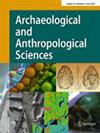Mobility to and from cities represents an essential aspect of urban development in Flanders (Belgium) during the second half of the Middle Ages (AD 1000 – AD 1500). The city of Ypres was situated in one of the core regions of medieval urbanisation in Europe. Nevertheless, many uncertainties about the movement of men, and especially women and children remain. Oxygen and strontium isotope analyses were conducted on 113 individuals recovered from Ypres’ St. Nicholas parish cemetery (13th -14th centuries). The 87Sr/86Sr of the individuals suggests that a significant amount of foodstuffs available in the city probably originated from (present-day) northern France. Furthermore, 17% of the sampled population dating to before the arrival of the Black Death in Ypres in AD 1348 (14 individuals) does not reflect the values of the food and water sources available inside Ypres as their isotope results differ from the rest of the population. Nearly all of their oxygen values (11 out of 14) are compatible with areas just outside the city’s water reservoirs, suggesting that most of the mobility to and from the city occurred within the city’s vicinity. The absence of a statistically significant difference between males and females indicates that both moved to a similar extent, already before the Black Death. Evidence for mobility before the age of 9, both to and away from Ypres, suggests that this mobility was likely related to children moving towards family, moving for educational purposes, or that child labour might have happened at a younger age than expected. This study provides new insights into the mobility patterns of the inhabitants of medieval urban Ypres.


